What is difference between Chambray And Denim?
Fabrics are a large and diverse market that is very segmented. As two varieties of woven fabrics, chambray and denim have similar appearances, closely related histories, and substantially different characteristics. While What is the difference between chambray and denim? After all, friends from clothing manufacturers or trading companies are not on the front line of textile production, and these words circulating on the Internet are not enough to fully answer their doubts. Therefore, we feel it is necessary to do a simple combing to reveal the inherent differences between the two, so as to facilitate our customers to efficiently purchase suitable fabrics.
Let’s first look at the traditional definitions of the two:
The formal scientific name of denim is Denim fabric. It is a thicker yarn-dyed warp twill cotton fabric. The warp yarns are dark in color, usually indigo, and the weft yarns are light in color, usually light gray or off white. Also known as indigo labor cloth. It began in the western United States and was named after herders used it to make clothes. The warp yarns adopt a sizing dyeing combined with one-step dyeing process, with high warp and weft special numbers. Generally, 3/1 weave is used, with a tight and thick texture. It is suitable for men’s and women’s jeans, denim tops, denim vests, denim skirts, etc.
Chambray, its fabric structure is mainly plain weave, and is a cotton fabric made of interwoven single-color warp yarns and bleached weft yarns or bleached warp yarns and single-color weft yarns. In use, it is mostly used for casual wear. The color is mostly medium color. Even if darker warp yarn (or weft yarn) and white weft yarn (or warp yarn) are interwoven, the color presented on the cloth is still medium light color. The fabric surface has a two-color effect, the fabric is harmonious in color, light and thin in texture, smooth and soft. It is named because it is suitable for young people’s clothing. It is often used as shirts, shoe and hat fabrics, underwear fabrics, home textile fabrics and quilt covers, etc. Denim Chambray Fabric which used for denim shirting is one of the chambray fabrics.
These definitions themselves are correct, but our textile production processes are also changeable. Therefore, if you rely solely on the above content, it is easy to fall into the following misunderstandings:
Misunderstanding 1. It is mistakenly believed that denim is twill and chambray is plain. Correction: This understanding is correct in the traditional sense, but in fact, denim also has plain weave, and chambray also has twill weave. As shown in the picture below, the left is pure cotton twill yarn-dyed chambray, and the right is plain denim.
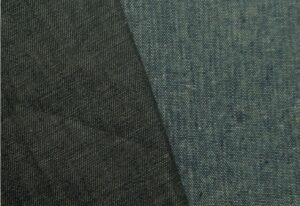
Misunderstanding 2. It is mistakenly believed that denim is thick and is used for pants, while chambray is thin and is used for shirts.
Correction: This understanding was probably correct at the beginning, but now, denim can be thin and chambray can be thicker. As shown in the picture below, the left is hemp-cotton blended 16S thickened and encrypted chambray, and the right is Tencel 21S twill denim. In comparison, the one on the right is softer.
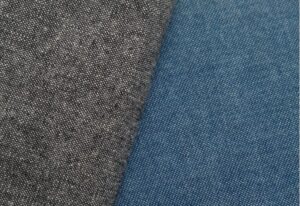
Misunderstanding 3. It is mistakenly believed that the colored yarn of denim is white and the colored yarn of chambray is bleached.
Correction: It should be easy to change the color of the yarn. The colored yarn of chambray was originally bleached, but now it is also white. As shown in the picture below, if you look closely, the white gauze of the blue chambray is whiter than the white gauze of the dark gray chambray. The latter uses original white gauze, which is slightly yellower, revealing a simple style.
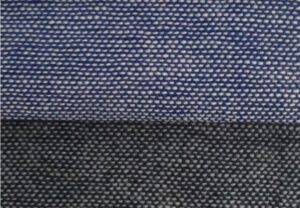
As mentioned before, the world of fabrics is a large market with very segmented varieties, so we cannot be too cautious in our words and deeds. We do not intend to make a comprehensive comparison of the differences between chambray and denim from yarn dyeing to garment making, but in terms of summarizing the principles and experiences of daily production and processing, the main difference between the two is still: different dyeing processes lead to Whether it can be washed off. Denim can produce a certain fading effect after being washed or sand washed. Chambray is a pure yarn-dyed fabric and will not fade under regular washing.
The first three colors from the top right to the bottom in the picture below are all “washed” from the same dark denim (i.e. the bottom one).
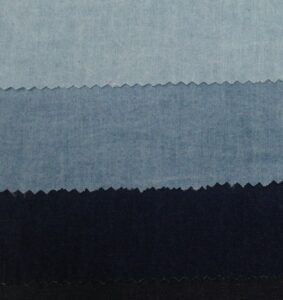
Denim undergoes washing, stone-polishing and other processes before making clothes in order to create a fading effect and frosty white look on the cloth surface; while chambray is usually washed after being made into garments. It is used to complete the pre-shrinking and shaping of the size and remove the hair neppys on the fabric surface. As shown in the picture below, chambray with good color fastness will not fade after washing. It may be due to shrinkage that the cloth surface is slightly tight and the color appears slightly darker.
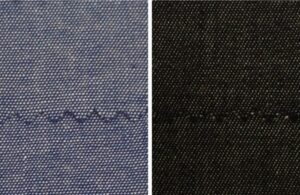
Therefore, if you come across chambray that fades when washed, you may have mistaken it and it is actually denim. Of course, it may also be chambray that does not meet the color fastness standard.


